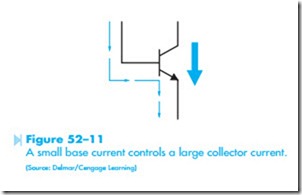TRANSISTOR OPERATION
The simplest way to describe the operation of a transistor is to say it operates like an electric valve. Current will not flow through the collector-emitter until current flows through the base-emitter. The amount of base-emitter current, however, is small when compared to the collector-emitter current, Figure 52–11. For example, assume that when one milliamp (mA) of current flows through the base- emitter junction, 100 mA of current flows through the collector-emitter junction. If this transistor is a linear device, an increase or decrease of base current will cause a similar increase or decrease of collector current. For instance, if the base current is increased to 2 mA, the collector current would increase to 200 mA. If the base current is decreased to .5 mA, the collector current would decrease to 50 mA. Notice that a small change in the amount of base current can cause a large change in the amount of collector current. This permits a small amount of signal current to operate a larger device, such as the coil of a control relay.
One of the most common applications of the transistor is that of a switch. When used in this manner, the transistor operates like a digital device instead of an analog device. The term digital refers to a device that has only two states such as on or off. An analog device can be adjusted to different states. An example of this control can be seen in a simple switch connection. A common wall switch is a digital device. It can be used to either turn a light on or off. If the simple toggle switch is replaced with a dimmer control, the light can be turned on, off, or adjusted to any position between. The dimmer is an example of analog control.
If no current flows through the base of the transistor, the transistor acts like an open switch and no current will flow through the collector-emitter junction. If enough base current is applied to the transistor to turn it completely on, it acts like a closed switch and permits current to flow through the collector-emitter junction. This is the same action produced by the closing contacts of a relay or motor starter, but a relay or motor starter cannot turn on and off several thousand times a second and a transistor can.
